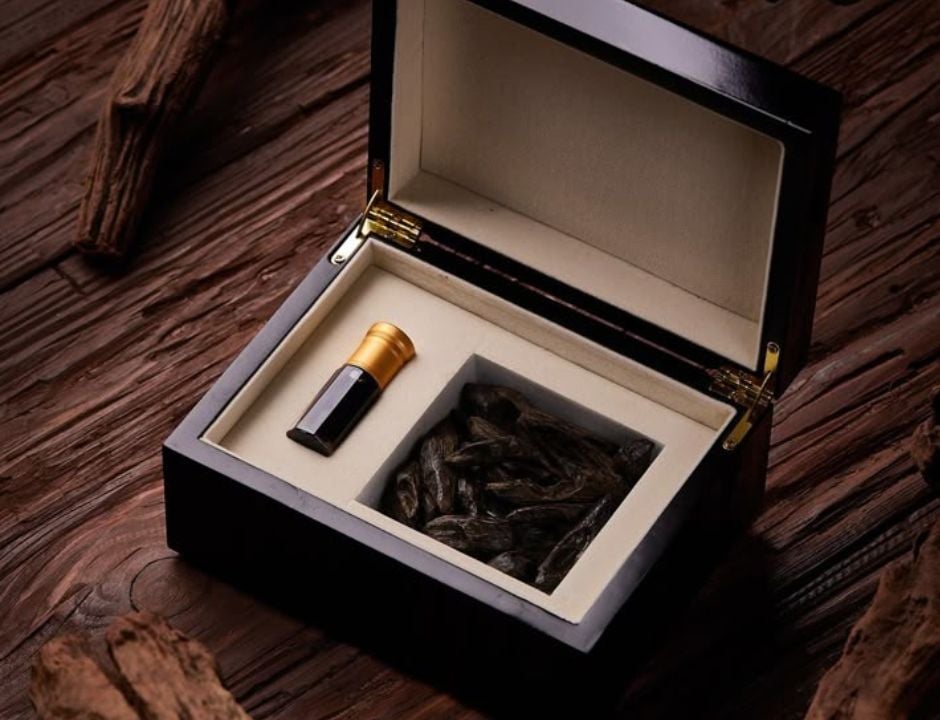Throughout the Eastern world, oud has been found to tell many stories and tales throughout the ages. Among these stories, oud has emerged as one of the protagonists, the wood that grows in the earth and transports us to worlds of luxury. But oud is not alone in this journey. There is also oud oil, rare drops that carry a special magic and an irresistible scent. But what is the difference between oud and oud oil? In this article, we will explore the differences between them and discover how each represents an important part of the luxury perfume industry.
What is the difference between oud and oud oil?

Oud and oud oil are among the most important natural ingredients used in the perfume and incense industry. Although they both come from the same source, there are some differences between them in terms of their extraction method, properties, and uses.
What is oud?
Oud can be defined as the wood extracted from Aquilaria trees, a tree that grows in tropical regions of Southeast Asia, specifically in countries such as India, Cambodia, Laos, and Thailand. There are a variety of types of oud, the most prominent of which are Indian, Cambodian, and Laotian.
Oud is a valuable aromatic material used in the perfume industry due to its rarity and distinctive scent, which results from the infection of the tree with certain fungi, which results in the production of dark wood with a pungent odor. The infected parts are extracted through a precise process to obtain original oud wood.
Oud properties
Agarwood is distinctive in color and texture, with a warm, rich aroma that ranges from sweet to smoky, and can contain woody and spicy notes. This aroma makes it a staple ingredient in incense, used primarily in spiritual rituals and cultural traditions.
Use it
Oud is used to scent gatherings and homes. It is burned directly on charcoal or in incense burners, filling the air with a rich, distinctive scent. Oud is a scent that helps calm the nerves and promote a sense of relaxation.
What is oud oil?
After defining oud, we can easily move on to defining oud oil. It is the aromatic oil extracted from agarwood through a complex and lengthy distillation process. This process requires the use of high temperatures and continuous distillation for several days or even weeks, resulting in the extraction of pure, concentrated oil from the wood. After certain degrees of filtration, this has led to a variety of oud types on the market, ranging from first, second, and third grade. This depends on the filtration stages, with the lower the filtration degree, the higher the quality of the oud oil.
Properties of oud oil
Oud oil is a dense, fragrant oil with a strong, warm scent that is sharp and elegant. It is considered one of the rarest and most expensive essential oils in the world. This scent is deeper and more concentrated than that of raw oud, and it has a long shelf life, lasting several hours on the skin. Therefore, oud oil is considered one of the finest and most expensive ingredients in the luxury perfume industry.
Use of oud oil
Oud oil is primarily used in the luxury perfume industry, where it is added to high-end fragrances to give them a touch of luxury and distinction. Oud oil is also used in some traditional remedies and in skincare products due to its soothing and nourishing properties.
These are the most important and prominent differences that answer the question: What's the difference between oud and oud oil? In terms of manufacturing method, usage, and characteristics, you may be wondering: How do I identify authentic oud oil? Below, we'll answer the most important signs by which you can identify authentic oud oil.
How do I know the original oud oil?
There are several differences that you can use to identify original oud oil, the most important of which are:
- Scent: The scent of oud is characterized by its high stability that lasts for long periods without changing, while imitation types often have weak stability or change quickly.
- Price: Price is one of the most important differences between original and imitation oud oil, as the price of original oud oil is higher than other types. Therefore, if the price is unreasonably low, this may be evidence that it is not original.
- Color: The color of real oud oil tends to be dark brown or black, and this color does not change over time. Any other color, such as yellow or light brown, may indicate that the oud oil is adulterated or has been enriched with other ingredients.
- Effects on the nose and eyes: Genuine oud oil does not cause any itching or sensitivity when inhaled, and its effect on the nose and eyes is mild. Other or imitation types, however, may irritate the eyes or nose.
Finally, oud wood and genuine oud oil have unique properties that make them unparalleled in their long-lasting scent and high quality. Each has its own uses. If you're looking for high-quality, genuine oud oil, don't hesitate to order it now from Oud Abdul Malik. We offer you the finest, guaranteed products imported from reliable sources. Enjoy a luxurious, long-lasting fragrance!

